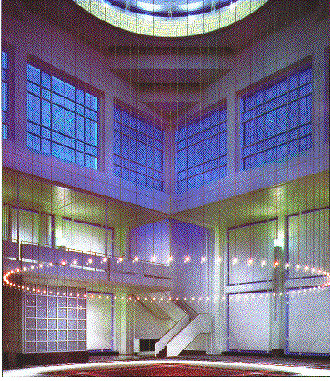|
The New York Mosque
Building the Mosque
New York City is a melting pot of nationalities,
races, and religions. There is something to offer everyone. However,
for the Muslim community was without a proper place to worship
for many years. It was not until five years ago that a mosque
was built for them, but this took many years in the making.
It began in 1966 when the governments of Kuwait,
Saudi Arabia, and Libya donated money for the construction of
a mosque in New York City. With this money they purchased a piece
of property in upper Manhattan. Not until 1987 did the Board of
Trustees reach an agreement on the beginning of work on the mosque.
The goal was to build a mosque that conformed to traditional
Islamic architectural style, while at the same time updating it with a
modern look compatible with the surrounding New York City buildings.
The completion of construction was in 1990 with the official opening
on September 25, 1991. The ceremony was presided over by H.H.
the Emir of Kuwait, Sheikh Jaber Al Ahmad Al Jaber.
The Architecture
When passing the Mosque while walking down
the street one may not even realize what is because of its modern
features. Study the old architecture of the ancient mosques of
the middle ages and one will see that it has the same basic shape
and characteristics.
At the end of the seventh century [of the Common Era], Muslim
rulers were firmly established in their conquered domains. They
began to erect mosques and palaces on a large scale as visible
symbols of their power. They were made by craftsmen gathered from
Egypt, Syria, Persia, and Byzantium who built in the styles they
were trained in. By the eighth century these styles had synthesized
to form an Islamic tradition.
An Old Tradition
One feature that was common with all mosques
was the marking of the qibla. The qibla is the direction
to which Moslems turn in praying to Allah. They pray in the direction
of Mecca. The qibla is emphasized by a colonnade. In the
New York Mosque, the qibla is marked by a gold, squared
arch that is detailed in scrolls. Within this arch are glass arches
that become smaller by each pane. This gives it a look of depth,
as if the qibla is leading somewhere.
The Turkish Input
The New York Mosque is perhaps more similar to the
Turkish mosques that began being built in the tenth century. This
style of mosques was called Madrasah. The mosques built before
the tenth century used many columns and aisles. The Turkish mosques,
like the New York Mosque, had a simple, large, open space.
Use of Space
 Space
was an essential characteristic of mosques. There were many cavities
that prevented the viewer from seeing the end of walls. It gave
the mosque a limitless, fluid look. The New York Mosque also
bears this characteristic. There are many depths to the walls
emphasized by the white of the walls and the glass. Space
was an essential characteristic of mosques. There were many cavities
that prevented the viewer from seeing the end of walls. It gave
the mosque a limitless, fluid look. The New York Mosque also
bears this characteristic. There are many depths to the walls
emphasized by the white of the walls and the glass.
The interior of the Mosque can be compared
to Hagia Sophia,
a church built in 532-37 in present day Istanbul (what was then
Constantinople). The Hagia Sophia had many openings that let light
giving it the illusion of floating. The Mosques also makes use
of this image. With the interior lights, the hanging lights, and
the natural light filtering in from the outside, the Mosque looks
celestial. Unlike an Orthodox church, however, the mosque has
no figurative decorations to detract attention from God, nor divisions
on the floor to allow elaborate liturgies. It is a common space
to gather the Muslim community in prayer before the one absolute
divinity.
Modern Elements
The exterior of the Mosque retains the basic
square shape of the Hagia Sophia and other mosques of which followed
that type. The difference, and this comes with the modern construction,
is that the New York Mosque is more rigid, geometrical. The Mosque
has the central dome of traditional Mosques without having the
half domes and smaller domes that were added to the medieval mosques.
The last characteristic that the Mosque bears
is the minaret. This is the tower used to summon the faithful
to prayer by the cry of the muezzin. The muezzin is the Muslim
official who proclaims from the minaret the hour of prayer.
The New York Mosque is a gem for its keeping
with traditional Islamic architecture and religious teachings.
It is open to the public, Muslim or non-Muslim, and welcomes those
who would like to experience their prayer. It is located on 3rd
Avenue between 96th and 97th streets.
Islamic Links
Back to Medieval New York Page
This Page is part of the Medieval New York Web Project, a project of students in the Introduction to Medieval History courses taught by Paul Halsall in the History Department of Fordham University in
1996-1997.
© Copyright to the student creator of each page
The Internet History Sourcebooks Project is located at the History Department of Fordham University, New York. The Internet
Medieval Sourcebook, and other medieval components of the project, are located at
the Fordham University Center
for Medieval Studies.The IHSP recognizes the contribution of Fordham University, the
Fordham University History Department, and the Fordham Center for Medieval Studies in
providing web space and server support for the project. The IHSP is a project independent of Fordham University. Although the IHSP seeks to follow all applicable copyright law, Fordham University is not
the institutional owner, and is not liable as the result of any legal action.
© Site Concept and Design: Paul Halsall created 26 Jan 1996: latest revision 12 April 2024 [CV]
|